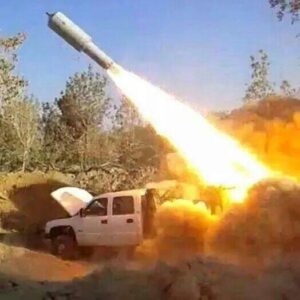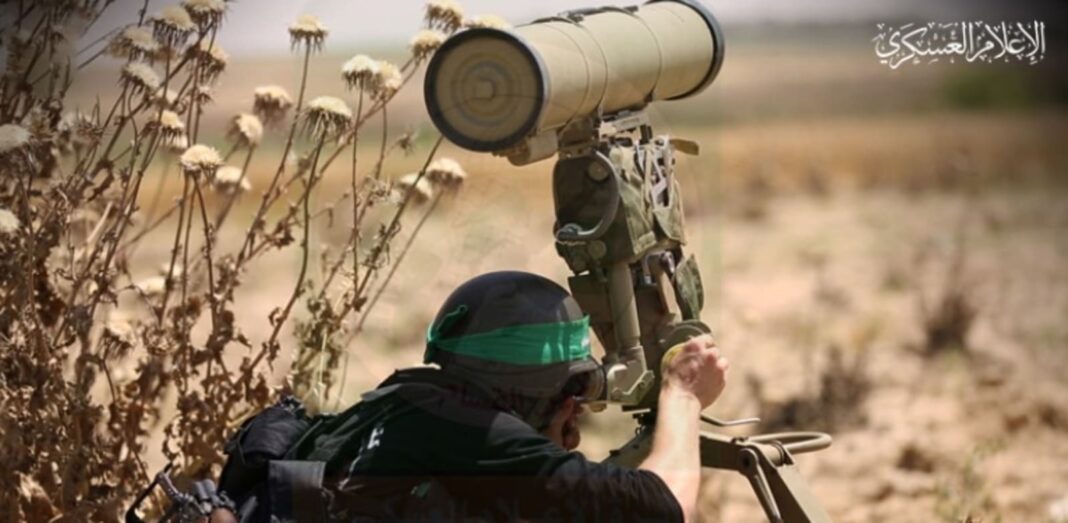|
Getting your Trinity Audio player ready...
|
An Examination of the Threat Posed to Israel by Hezbollah’s Anti-Tank Missiles & Rockets
Edited by: Fern Sidman
In the ongoing Israel-Hamas conflict, the involvement of Hezbollah has introduced a significant and multifaceted threat, particularly through the use of advanced anti-tank missiles. Among these, the Kornet anti-tank missile stands out for its effectiveness and precision. It is noteworthy to explore the capabilities and implications of Hezbollah’s anti-tank missile arsenal, examining how it impacts both military operations and civilian infrastructures in Israel.

Hezbollah’s primary anti-tank weapon is the Kornet missile, including its upgraded versions. The Kornet anti-tank guided missile (ATGM), developed by Russia in the 1990s, is renowned for its precision and destructive power. It uses a laser-guided system to ensure accuracy and can penetrate even the most robust armor. The missile features a tandem-warhead system that includes a primary charge to breach armor and a secondary charge to deliver a devastating explosion inside the target. Its effective range extends from 100 meters to 8 kilometers, making it versatile for various combat scenarios.
Specifications and Mechanism
Warhead: The Kornet carries a 4.6 kg explosive charge capable of penetrating up to 1,200 mm of armor. The warhead can be either a hollow charge or a thermobaric variant, which disperses a flammable cloud and metal particles to maximize damage.
Guidance System: The missile uses a laser beam riding system, allowing for precise targeting with minimal deviation. This system enables the missile to adjust its trajectory mid-flight to maintain accuracy.
Deployment: The Kornet can be launched from a portable tripod or mounted on vehicles, enhancing its operational flexibility.
Impact: The Kornet’s dual-stage explosive mechanism makes it particularly effective against armored vehicles and tanks. However, it also poses a significant threat to stationary military installations and civilian targets.
Hezbollah has integrated the Kornet into its arsenal with significant effect. These missiles have been supplied by Iran, which acquired them from Russia, and have been used extensively against Israeli targets. Hezbollah’s proficiency with the Kornet was first demonstrated during the 2006 Lebanon War, where the missile successfully penetrated Israeli Merkava tanks and caused substantial casualties.
Hezbollah has adapted the Kornet for various uses beyond its original anti-tank role, employing it against fortified positions and low-flying aircraft. The missile’s ability to cause severe damage to both military and civilian targets makes it a potent tool in asymmetric warfare.
Hezbollah’s strategy has evolved to target not only military assets but also critical civilian infrastructure. This shift is evident in the deployment of other missile systems, such as the Burkan rocket. The Burkan, while not a precision-guided munition (PGM), carries a substantial explosive payload capable of causing significant damage over a wide radius.
The Israeli Defense Forces (IDF) have developed the Trophy active protection system, also known as Windbreaker, to counteract the threat posed by anti-tank missiles like the Kornet. The Trophy system is highly effective at neutralizing incoming missiles, protecting armored vehicles from such threats. However, this technology is limited to military applications and does not extend to civilian infrastructure, which remains vulnerable.
Hezbollah’s possession of the Kornet missile, along with other advanced weaponry, highlights the escalating threat to regional stability. The group’s ability to target critical infrastructure, such as power grids and communication networks, raises the specter of widespread disruption and psychological terror.
The Burkan Rocket: Capabilities and Specifications
The Burkan rocket is a heavy-duty, short-range missile developed with significant assistance from Iran and Syria. This weapon has been part of Hezbollah’s arsenal since the Syrian Civil War and has been used effectively against both military and civilian targets in Israel.
Specifications
Warhead: The Burkan can carry an explosive payload ranging from 100 to 500 kilograms, capable of causing extensive destruction within a 150-meter radius. Some reports suggest that the warhead can be customized with various types of explosives, enhancing its versatility and impact.
Range: The rocket has an effective range of up to 10 kilometers, making it suitable for targeting both near-border installations and deeper strategic targets within Israel.
Launch Mechanism: The Burkan is typically launched from small trucks or ground-based platforms, allowing for mobility and flexibility in its deployment.
Hezbollah has utilized the Burkan rocket in several notable attacks against Israeli military bases and civilian areas. One significant instance occurred on November 4, 2023, when Burkan rockets were fired at a military base in northern Israel, causing significant damage although no casualties were reported due to prior evacuation of the site. This highlights the rocket’s psychological impact as well as its physical destructive power.
The Burkan rocket’s origins trace back to the Syrian Civil War, where it was employed by Assad’s forces and allied Iranian Shiite militias in urban combat scenarios, causing massive destruction. Hezbollah has since adopted and refined this weapon for use against Israel, integrating it into their broader strategy of asymmetrical warfare.
The introduction of the Burkan rocket into Hezbollah’s arsenal poses several strategic challenges for Israel. Its ability to deliver heavy explosives over relatively short distances makes it a formidable threat to both military targets and critical civilian infrastructure such as power grids and communication networks.
The Israel Defense Forces have developed several countermeasures to mitigate the threat posed by the Burkan rocket. These include:
Iron Dome: While effective against many types of rocket attacks, the short range and low altitude of the Burkan present unique challenges for this system.
Laser Interception: There are ongoing efforts to deploy laser-based defense systems that can “cook” critical parts of the rocket in flight, causing it to fail before reaching its target.
Offensive Operations: Targeting the launch platforms and supply chains of Hezbollah to prevent the deployment of these rockets.
The deployment of these missiles by Hezbollah has far-reaching implications. Strategically, the ability to target a wide array of installations complicates defensive measures and strains resources. Psychologically, the threat of missile attacks creates an environment of fear and uncertainty, affecting both military personnel and civilians.
The IDF and Israeli government officials are acutely aware of the risks posed by Hezbollah’s missile arsenal. Measures are continually being developed and refined to protect critical infrastructure and civilian populations. Enhanced early warning systems, fortified structures, and comprehensive emergency response plans are part of the broader strategy to mitigate these threats.
Hezbollah’s use of advanced anti-tank missiles such as the Kornet, along with the deployment of rockets such as the Burkan, presents a significant challenge in the Israel-Hamas conflict. The precision and destructive power of these weapons highlight the need for robust defensive measures and strategic planning. The courage and resilience of those defending against these threats are crucial in maintaining security and stability amidst ongoing hostilities.





